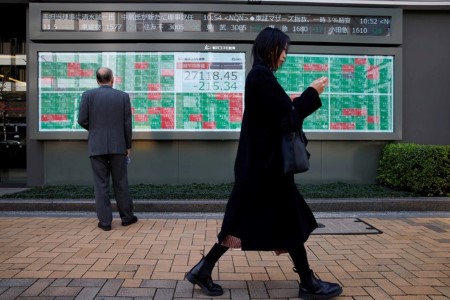




Philippines Trade Update: Trade trajectories trend along
 DOWNLOAD
DOWNLOAD

Policy Rate Updates: Double cut finale
 DOWNLOAD
DOWNLOAD

Monthly Economic Update: One for the road
 DOWNLOAD
DOWNLOAD


Consolidation, at a dovish inflection point

Nov 16 – A bout of consolidation across Asian markets on Thursday is likely after the previous day’s stellar gains, as investors adjust to what appears to be a decisive moment in the global interest rate and inflation cycle.
There is a growing consensus forming that major central banks’ interest rate-raising cycle is over, a conviction strengthened by a series of inflation reports and other indicators from major economies.
Figures on Wednesday showed that US producer prices fell at their fastest pace since April 2020, and UK consumer inflation undershot all forecasts. Oil prices fell again on Wednesday, and are now down more than 10% year-on-year.
Investors are increasingly pricing in more rate cuts next year, bond yields and the dollar are coming under downward pressure, and stocks and risk assets are buoyant. All in, financial conditions in most countries are loosening.
Some of that reversed on Wednesday – Treasury yields and the dollar rebounded a bit from the previous day’s slump – which may keep a lid on Asian markets on Thursday, even though Wall Street held onto its gains and closed higher.
Investors could be forgiven for taking a breather on Thursday after such as huge rally on Wednesday that saw the MSCI Asia ex-Japan, MSCI Emerging Market index, and Japan’s Nikkei 225 all post their biggest gains in a year, of 2.5% or more.
But they also have other major economic and corporate news to digest, which will inject an extra dose of caution into the trading session.
The economic calendar sees the release of Japanese trade data, machinery orders, and the closely watched ‘tertiary activity index’, as well as Australian unemployment and Chinese house prices.
Japan’s GDP figures on Wednesday were much weaker than expected, leading economists at Barclays and elsewhere to cut their 2023 and 2024 growth forecasts.
But financial conditions in Japan are the loosest since 1990, according to Goldman Sachs, which is partly why the Bank of Japan has stepped up its hawkish rhetoric and may end its negative interest rate policy early next year.
Laying that ground at a time when the economy is shrinking, however, is not ideal.
China’s house price data will be closely watched for signs that the property sector is beginning to stabilize. There are signs of stabilization elsewhere in Chinese markets – the yuan is its strongest in three months against the dollar, and foreigners are increasing their holdings of China’s onshore yuan bonds.
On the policy front, the Philippine central bank is expected to keep its key interest rate unchanged at 6.50% on Thursday, although there’s an outside chance it might hike to 6.75%.
On the corporate front, China’s Alibaba and Lenovo released their latest earnings reports.
Here are key developments that could provide more direction to markets on Thursday:
– Japan trade (October)
– China house prices (October)
– Philippines interest rate decision
(By Jamie McGeever)
This article originally appeared on reuters.com





 By Reuters
By Reuters